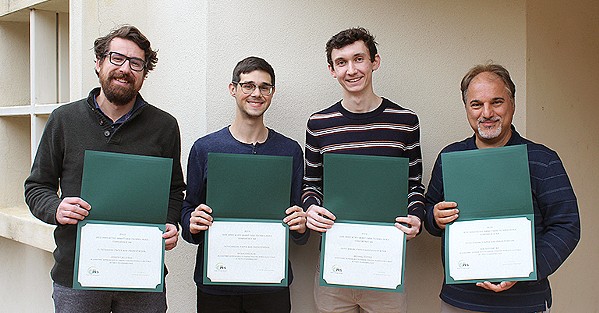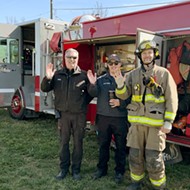[{
"name": "Newsletter Promo",
"id": "NewsletterPromo",
"class": "inlineCenter",
"insertPoint": "4",
"component": "15264767",
"requiredCountToDisplay": "0"
},{
"name": "Ad - Medium Rectangle CC01 - 300x250",
"id": "AdMediumRectangleCC01300x250",
"class": "inlineCenter",
"insertPoint": "8",
"component": "2963441",
"requiredCountToDisplay": "12"
},{
"name": "Ad - Medium Rectangle LC01 - 300x250",
"id": "AdMediumRectangleCC01300x250",
"class": "inlineCenter",
"insertPoint": "18",
"component": "2963441",
"requiredCountToDisplay": "22"
},{
"name": "Ad - Medium Rectangle LC09 - 300x250",
"id": "AdMediumRectangleLC09300x250",
"class": "inlineCenter",
"insertPoint": "28",
"component": "3252660",
"requiredCountToDisplay": "32"
}]
Two Cal Poly engineering professors' concern for preserving the environment for future generations sparked a trailblazing project with intentions to prevent widespread fires.
Majid Poshtan and Joseph Callenes-Sloan—associate professors of electrical engineering and computers, respectively—advanced a software program that can be attached to high-power transmission lines and detect fledgling local fires, their growth, and the direction in which they could spread. The innovation won them a breakthrough patent in September for the program, which the engineers had been working on since before the pandemic began.
"All the pictures that I saw from wildfires were mainly caused by transmission lines in forests and other places with lots of vegetation and then it expanded to the cities and towns," Poshtan told New Times on Dec. 28. "I thought at least I can help with preventing fire caused by high-power transmission lines."
The idea struck him when he attended an electrical engineering conference in Washington, D.C., in 2019. Poshtan connected with an industry peer whose company designed a sensor that measures the sag of transmission lines. Although utility companies must make sure there's enough space between the wires and trees so that the high power from the cables doesn't spark fires, Poshtan said, utility wires can sag downward due to high ambient temperatures, direct sunlight, or high current inside the cables.
According to Poshtan, utility companies keep the power running through the transmission lines below the maximum capacity because of the chance of overheating that could cause the wires to droop to dangerous levels. Low hanging cables can brush across tree canopies and possibly ignite them in the process. The company Poshtan came across designed a sensor that could continuously measure the sagging and keep it at safe levels, which enables utility companies to maximize the power without compromising safety.
"At the conference, I thought, 'What if there's fire and it will cause heat on transmission line and expand the sag?'" Poshtan said.
He discussed the idea with Callenes-Sloan and the pair recruited students to help. Together, they ran a simulation to test the speed of heat transfer. The group discovered that when a fire breaks out, its heat transfers to transmission lines much faster by radiation than by convection and conduction.
Their work and Poshtan's networking at the conference paid off. The company with the sag sensor agreed to allow Poshtan and Callenes-Sloan's group to access its software and develop their research. The sensor's software uses cellular communication and wirelessly sends the data to the utility company's operating center. Poshtan requested to keep the company's name anonymous.
"With the same raw data that they receive, we can separate if sag is coming from ambient heat from sunbeams or from a local source of heat," Poshtan said. "We started to develop our own software."
Poshtan and Callenes-Sloan used the company's hardware and layered their newly developed software over the existing one, making it smarter in the process. Their version of the program collected data about local heat sources every 20 seconds. Theoretically, that data would be sent to the utilities operator who can then decide whether to call in emergency services.
"We knew that sooner or later, power utilities will buy that sensor for sag, and if they have that, they can get our software and also use it for fire detection," Poshtan said. "You don't need satellites, cameras, or a power source. This device is sitting on the transmission line and getting the power from the line."
The professors contacted the San Luis Obispo Fire Department in 2020 to test out their software. The department suggested conducting a trial run during fire drills, but the onset of the pandemic prevented that test from happening. Still, Poshtan and Callenes-Sloan continued to develop the software, even testing it on multiple transmission lines.
"We learned that in Europe it is mandatory to buy that sensor. In New York, they've already installed it," Poshtan said. "We knew that it is coming to the West Coast, and the moment it comes, we have some products that can help the environment."
In fact, Poshtan added that two utility companies are expressing interest in their software. They're in talks with those groups to iron out the finer details. Even the students who ran the heat detection software to test its efficiency are experiencing success. Some of them launched a startup called Perch Sensing Inc. and they received $150,000 from the California Energy Commission to develop their own sensor.
Fast fact
• Big Brothers Big Sisters of SLO County is hosting Healing Bridge: Mentoring's Role in Healing from Trauma on Jan. 20 at 2 p.m. at Unitarian Universalists Church in SLO. For more information, contact Caity McCardell at (805) 540-1926 or [email protected]. Δ
Reach Staff Writer Bulbul Rajagopal at [email protected].









